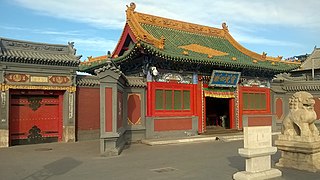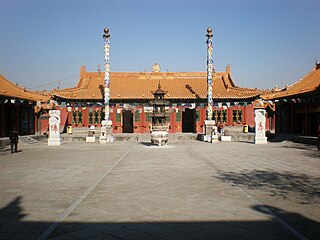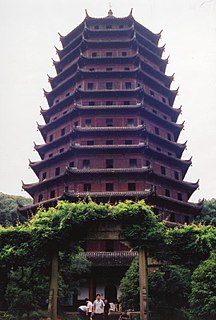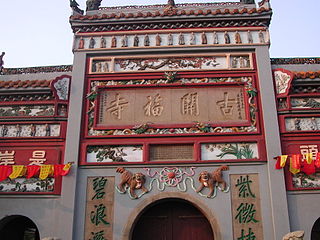See also
- Gyokusen-ji, Buddhist temple in Shimoda, Shizuoka Prefecture, Japan
Yuquan Temple or Jade Spring Temple may refer to these temples:

Ningxiang is a county-level city and the 2nd most populous county-level division in the Province of Hunan, China; it is under the administration of the prefecture-level city of Changsha. The city is bordered to the north by Heshan District of Yiyang and Taojiang County, to the west by Anhua County and Lianyuan City, to the south by Louxing District of Loudi, Xiangxiang City, Shaoshan City and Yuhu District of Xiangtan,to the east by Yuelu and Wangcheng Districts. Located in the central east of Hunan Province, Ningxiang covers 2,906 km2 (1,122 sq mi) with a registered population of 1,393,528 and a resident population of 1,218,400. The city has 4 subdistricts, 21 towns and 4 townships under its jurisdiction, its administrative centre is at Yutan Subdistrict (玉潭街道).

Yichun (Chinese: 宜春; pinyin: Yíchūn; Wade–Giles: I2-ch'un1; postal: Ichun) is a mountainous prefecture-level city in western/northwestern Jiangxi Province, China, bordering Hunan to the west. Yichun literally means "pleasant spring". It is located in the northwest of the province along a river surrounded by mountains. Yichun has a profound Buddhist culture. "Can Lin Qing Gui", the monastic rules for Buddhists at the Buddhist temple, originated from Yichun. Yichun is also the birthplace of a number of literary figures, such as Tao Yuanming and Deng Gu, both of whom are poets from ancient times.

The Xilitu Zhao, also known as Shiretu Juu or by formal Chinese name Yanshou Temple (延壽寺) is an ancient Tibetan Buddhist monastery of the Gelugpa sect in Hohhot, the capital of Inner Mongolia, China. The original temple was built in 1585, but was later destroyed by fire and rebuilt in the 19th century. It is located East of Dana Street in the Yuquan District, just across the road from the Da Zhao Temple.

Dangyang is a city in western Hubei province, People's Republic of China, lying 70 kilometres (43 mi) east of the Gezhouba Dam on the Yangtze River. During the Western Han Dynasty. Emperor Jing of Han established an administration in Dangyang on an area of 2,000 square kilometres (770 sq mi). In 1988 the State Council of the People's Republic of China elevated this from a county to a county-level city, and is currently under the administration of the prefecture-level city of Yichang.

Hengshan, is a mountain in southcentral China's Hunan Province known as the southern mountain of the Five Great Mountains of China. Heng Shan is a mountain range 150 kilometres (93 mi) long with 72 peaks and lies at 27°18′6″N112°41′5″E. The Huiyan Peak is the south end of the peaks, Yuelu Mountain in Changsha City is the north end, and the Zhurong Peak is the highest at 1,300 metres (4,300 ft) above sea level.

Da Zhao Temple or Wuliang Temple, or Ih Juu in Mongolian, is a Tibetan Buddhist monastery of the Gelugpa order in the city of Hohhot, Inner Mongolia in North China. It is the oldest and largest temple in the city and is located West of Danan Street in the Yuquan District.

The architecture of the Song dynasty (960–1279) was noted for its towering Buddhist pagodas, enormous stone and wooden bridges, lavish tombs, and extravagant palaces. Although literary works on architecture existed beforehand, architectural writing blossomed during the Song dynasty, maturing into a more professional form that described dimensions and working materials in a concise, organized manner. In addition to the examples still standing, depictions in Song artwork, architectural drawings, and illustrations in published books all aid modern historians in understanding the architecture of the period.

East Mountain Teaching denotes the teachings of the Fourth Ancestor Dayi Daoxin, his student and heir the Fifth Ancestor Daman Hongren, and their students and lineage of Chan Buddhism.

Yuquan District is one of four districts of the prefecture-level city of Hohhot, the capital of Inner Mongolia Autonomous Region, North China.
Yuquan may refer to:

Kaifu Temple is a Buddhist temple located in Kaifu District of Changsha City, Hunan province in the People's Republic of China. It includes Entrance, Hall of the Great Heroes, Assisted dnyana, Dining Room, etc. Kaifu Temple belongs to the Yangqi sect and Linji school of Buddhism. The temple is built within a 16,000 square metres (170,000 sq ft) area of land. For the reason that it was first built earlier than Changsha city, so there is a saying that "there comes first the Kaifu Temple, then the Changsha city".

Lushan Temple, is a Buddhist temple at Yuelu Mountain, Changsha, Hunan, China. It includes the Entrance, Hall of Great Heroes, Zazen room, and dining room, etc.

Dongyang Town is a town in Liuyang, Hunan, China. As of the 2016 census it had a population of 41,000 and an area of 106.9 square kilometres (41.3 sq mi). It borders Beisheng Town in the north, Jiaoxi Township in the east, Yong'an Town in the west, and Taipingqiao Town, Gejia Town and Changsha County in the south.

Yanxi Town is a rural town in Liuyang City, Hunan Province, People's Republic of China. As of the 2015 census it had a population of 32,000 and an area of 119.6-square-kilometre (46.2 sq mi). It is surrounded by Fushoushan Town of Pingjiang County on the north, Dahu Town on the northeast, Gugang Town on the west, Guandu Town on the east, and Yonghe Town on the south.
National Key Buddhist Temples in Han Chinese Area are national key ("important") Buddhist temples in areas traditionally associated with the Han Chinese in the People's Republic of China. The list was originally released on 9 April 1983 by the State Council, and included 142 Buddhist temples.

Yuquan Temple is a Buddhist temple in Dangyang, Hubei, China, first built in 593 during the Sui dynasty. Zhiyi sponsored the construction, and the name Yuquan was given by prince Yang Guang.

The Hall of Sangharama Palace is an important building in Han Chinese Buddhist temples. It is the east annex hall of the Mahavira Hall. "Sangharama" with the short form "garan" (僧伽藍摩), means "gardens of monks" (眾園). In Buddhism, it originally refers to constructing the base of monks' dormitories (僧舍) and later it refers to the general term of temples, including land and buildings.

Yuquan Temple, formerly known as Palace of the Goddess, is a Buddhist temple located in Tianxin District of Changsha, Hunan.

Shishuang Temple is a Buddhist temple located in the town of Jingang, Liuyang, Hunan, China. In ancient times, Shishuang Temple, Daowu Temple (道吾寺), Baogai Temple (宝盖寺) and Daguang Temple (大光寺) were called "Four Buddhist Temples in Liuyang".

Yuquan Subdistrict is a subdistrict in Dangyang, Hubei, China. As of 2020, it administers Niangniangmiao Residential Community (娘娘庙社区) and the following 15 villages: